Unit Theme: Appreciating My World, Nature and the Environment
Author: Lucy Andrus
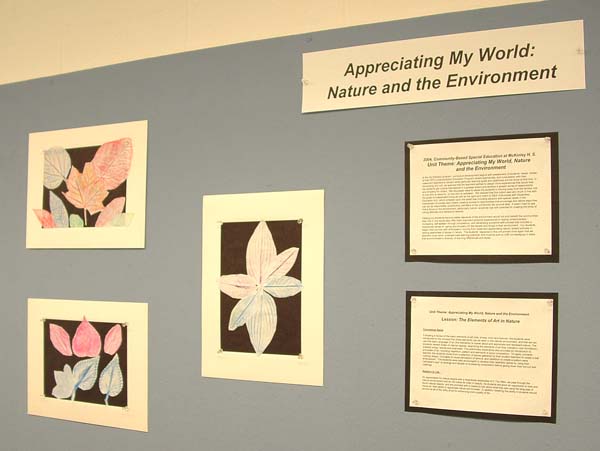
In the Art Partners program, curriculum development begins with assessment of students’ needs, review of their IEP’s (Individualized Education Program) where appropriate, and consultation with their classroom teachers to discern what particular learning goals and objectives are the focus at that time. In developing this unit, we learned that the teachers wished to design more experiences that would help the students get outside themselves to a greater extent and develop a greater sense of responsibility and empathy for others. We discussed ways to assist the students in moving away from the familiar role of one who is cared for, to one who is caretaker. We realized that this notion was very much in line with the goals of independent living as well as the spirit and intent of IDEA (Individuals with Disabilities Education Act), which is based upon the belief that including persons with special needs in the mainstream of society also means creating access to opportunities that encourage and define ways they can act as responsible, contributing members of the community like anyone else. It wasn’t hard to see that a focus on the environment, particularly nature, would be ripe with potential for creating the kinds of caring attitudes and behaviors desired.
Helping our students become better stewards of the environment would not only benefit the communities they live in, but would also offer them important personal experiences in raising consciousness, increasing self-esteem through competency, and developing a positive self-concept that includes a heightened sense of caring and empathy for the people and things in their environment. Our students began their journey with enthusiasm, moving from observers appreciating nature, toward activists in raising awareness of abuse in nature. The students’ response to this unit proved once again that we teachers must never underestimate learning potential, and must be sure to craft our pedagogy in ways that accommodate a diversity of learning differences and styles.
1. The Elements of Art in Nature
2. Nature as Inspiration for Art
5. Recognizing and Responding to Abuse in Nature Through Art
2004 Community-Based Special Education at McKinley High School
Lesson 1: The Elements of Art in Nature
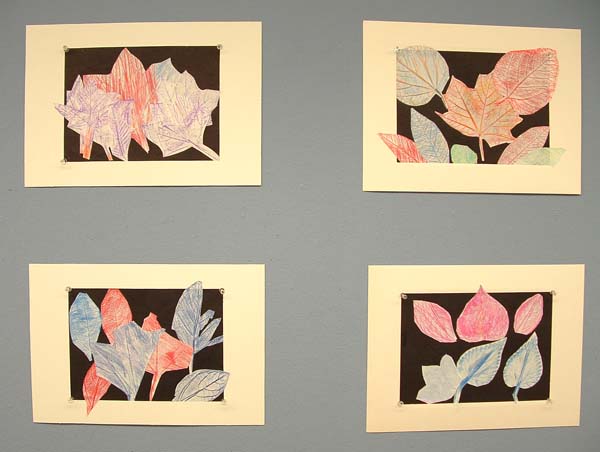
Conceptual Basis of the Lesson
Following a review of the basic elements of art (line, shape, color and texture), the students were introduced to the concept that these elements can be seen in the natural environment, and that we can use this basic language of art (the elements) to speak about and appreciate and represent nature. The students viewed slides of natural objects, describing the elements of art they noticed in rock formations, butterfly wings, leaves and examples. This preliminary experience also provided an introduction to principles of art, including repetition, pattern and elements of good composition. To apply concepts learned, the students chose from a selection of leaves gathered by their student teachers to create a leaf rubbing design. Concepts of visual perception of texture, and repetition to create a pattern were emphasized. The students were also encouraged to develop their aesthetic sense by using their “artmaker’s eye” to arrange and decide on a pleasing composition before gluing down their cut-out leaf rubbings.
Conceptual Basis of the Lesson
An appreciation for nature begins with a heightened awareness of it. Too often, we pass through the natural environment and do not notice its order or beauty. As students are given an opportunity to view and touch natural objects, and are provided with a means to talk about what they see using the language of visual art, their ability to appreciate nature will increase. In addition, fostering this ability in students should remind us all of the utility of art for enhancing one’s quality of life.
2004 Community-Based Special Education at McKinley High School
Lesson 2: Nature as Inspiration for Art
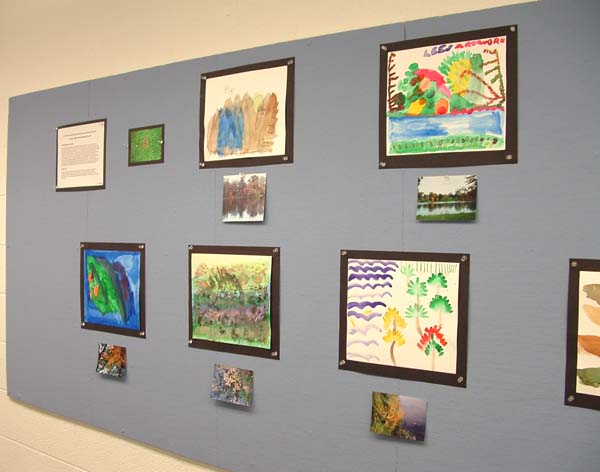
Conceptual Basis of the Lesson
In previous lessons, the students recalled the basic elements of art (line, shape, color and texture), viewed and discussed slides of these elements seen in natural objects, and viewed and discussed the work of environmental artist, Andy Goldsworthy. Then it was time to get out into nature and take a closer look firsthand. Armed with digital cameras to record, the students walked through Delaware Park, taking images of things they found beautiful or interesting and that reflected what they had learned about elements of art. While at the park, the student also experimented with Goldsworthy’s practice of finding and arranging natural objects into pleasing compositions, and photographing them right in nature. Keith’s composition of sticks in the grass is displayed here. To prepare students for forthcoming lessons, they were also asked to take photographs of abuse they noticed at the park. For this lesson, the students examined ways that artists use nature as inspiration for their artwork, from literal depiction of an awe-inspiring scene, to abstract representation of emotions evoked by the beauty and power of nature. Our students created watercolor paintings inspired by one of their pictures taken at Delaware Park.

Relation to Life
Engaging in a personal aesthetic experience with nature through this painting activity should serve to reinforce the fact that the natural environment is present for our enjoyment and for our inspiration. Hopefully, this will influence the ways that these young adults think about and interact with the natural environment around them, encouraging a sense of empathy, and eventually, a call action in preserving this environments.
2004 Community-Based Special Education at McKinley High School
Lesson 3: Sharing How I Care
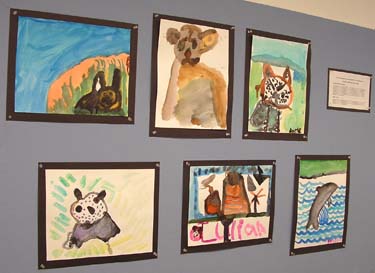
Conceptual Basis of the Lesson
In previous lessons, the students discussed the need to preserve our natural environments, observed and defined abuse in nature, discussed prevention of that abuse, and explored artistic ways of recycling and reusing materials. Building on these concepts, this lesson focused on the idea of activism by helping the students move from observers and recorders to activists raising awareness in others. For this experience, the students designed environmental posters for endangered animals. In addition to improving their ability to communicate visually, the students learned about “making an invitation” to others to take better care of their environment and the creatures in it. Displayed here are their initial paintings of an endangered animal.
Relation to Life
Understanding environmental activism empowers students who may otherwise feel that they can’t make a difference. Students are learning a new way to communicate with visual language in sharing their opinions with others. In the process, their sense of caring is growing and they are learning how to put that caring into action in making a difference.
2004 Community-Based Special Education at McKinley High School
Lesson 4: Re-use, Recycle, Respond
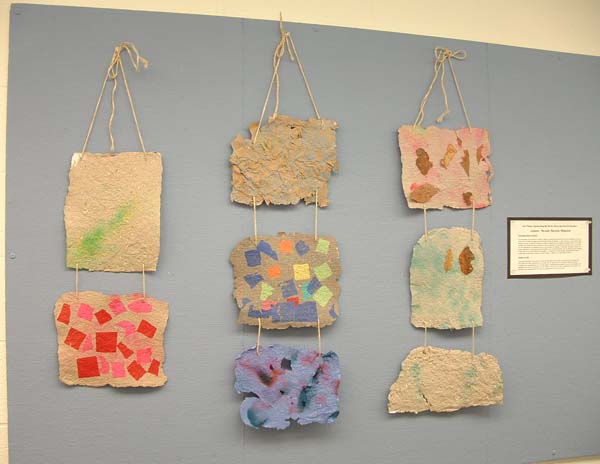
Conceptual Basis of Lesson
For this lesson, the students focused on ideas of re-using and recycling, and how artmakers can play an active role in furthering these environmentally-friendly processes. A quick look at our surroundings was enough for them to see the incredible numbers of objects that we dispose of everyday without a thought. Some of the students are also involved in sorting materials for recycling at home and in the community. For this experience, we wanted to focus on the re-use of a material, in this case old paper products, for artistic expression. Exploring the work of artists, such as Michael Albert, who re-use and recycle material in their artwork provided additional inspiration. In making their paper pieces, some students chose to incorporate actual natural objects into their designs, making for an interesting contrast.
Relation to Life
Students will discover how paper is made as they learn the concepts of reducing and recycling, and how paper and other products can be reused over to help solve environmental problems. As they increase their understanding of how artists seek to address environmental concerns in their artwork, the students will continue to develop their own ideas of ways in which they, as artmakers and citizens, can become more responsible for the care and preservation of the environment.
2004 Community-Based Special Education at McKinley High School
Lesson 5: Recognizing and Responding to Abuse in Nature Through Art
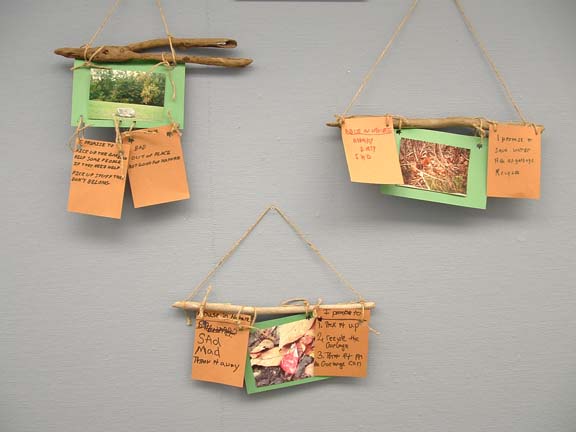
Conceptual Basis of Lesson
This lesson builds upon past lessons and art knowledge acquired and uses the pictures of abuse students had taken on their hike through Delaware Park. After laying the groundwork for understanding the essential language of art as a means to communicate aesthetic understanding and experience, the students took a closer look at nature, and the art found within it. Noticing this aspect of the natural environment also allowed the students to see that there are ways our natural environment can be abused as well. They studied the work of artists who have recognized abuse in nature and taken action by reclaiming abused land, or working with their findings to educate the community about this maltreatment of the environment. At this point, the students were able to recognize this abuse, and begin to articulate how they feel about it as well as what they could do to help solve the problem. Their mobiles are meant to reflect this thinking move toward greater action to address abuse in nature by sharing their work with the larger community.
Relation to Life
This lesson allowed the students to make their own art-based statements about the abuse they found and photographed in nature. By sharing this work, the students are hoping that others will become more aware and inspired to help reverse abuse of our natural environment. Understanding their potential as advocates and activists is important for the continued development of these young adults as they move toward assuming their place in the community as responsible and contributing members.

Fall 2002, School 68 Third Grade Inclusion Class
Lesson 6: Under the Big Top!

In this lesson on narrative in art, the children worked with their student teacher, Miss Stephanie, to continue the story of a circus scene they had studied in a Red Grooms painting, deciding as a group what would be happening in their diorama. The children thought that no circus story could be complete without a tightrope walker, a clown, and a motorcyclist jumping through a ring of fire!
This is a non-commercial website and is to be used for educational or research purposes only. No commercial use is permitted without the consent of Art Partners. "Fair use" is claimed under U.S. copyright law, sections 107 and 108. For questions contact:Art Partners
©2002 Art Partners Program | All Rights Reserved